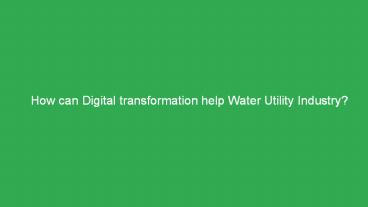How can Digital transformation help Water Utility Industry (1) - PowerPoint PPT Presentation
Title:
How can Digital transformation help Water Utility Industry (1)
Description:
The water utility industry is rapidly growing to meet the demands of a dynamic, highly deregulated and competitive market. But, the industry continues to struggle due to poor infrastructure, methods & minimal use of technology. The industry also continues to navigate the unsteady way to transform and resolve the issue. But failing terribly due to unavoidable factors like floods, increasing population, poverty, and lack of hygiene education among the users is backfiring the plan. – PowerPoint PPT presentation
Number of Views:29
Title: How can Digital transformation help Water Utility Industry (1)
1
How can Digital transformation help Water Utility
Industry?
2
The water utility industry is rapidly growing to
meet the demands of a dynamic, highly deregulated
and competitive market. But, the industry
continues to struggle due to poor infrastructure,
methods minimal use of technology. The industry
also continues to navigate the unsteady way to
transform and resolve the issue. But failing
terribly due to unavoidable factors like floods,
increasing population, poverty, and lack of
hygiene education among the users is backfiring
the plan.
3
The extreme climate changes are causing water
scarcities, creating ecological imbalance and
drying down the groundwater level. As a result,
arsenic contamination of groundwater is forming
which will have a deadly impact on human being's
health. One of the credible reports says over 137
million people are probably affected by arsenic
poisoning of drinking water.
4
Declining water quality has grown to be a global
concern, according to WHO (World Health
Organization), diseases due to poor
drinking-water access, unimproved sanitation, and
poor hygiene practices cause 4.0 of all deaths
and 5.7 of all disability or ill health in the
world. Improving ground level water, eliminating
the arsenic contamination, and making it potable
have been top challenges for the Water Utility
Industry.
5
Todays Water situation
There is nothing more crucial to life on earth
than clean water. But, the world has already
started to witness the worst scenarios of the
water crisis. The most recent Cape Town (South
Africa) and Flint, Michigan (USA) water issues
were the best examples. Cape Town was the first
city in the world to reach day zero which
indicates that the area was completely out of
water. Whereas in Flints case, the water was
contaminated due to insufficient water treatment.
Several reports claimed that the water had lead
substances and affected 100, 000 residents. Both
of the cities are still struggling to access the
water for drinking, cooking, bathing, and washing
hands. These incidences have alarmed future risks
and challenging the water utility industry to
wake-up and take necessary. To make the scenario
worse, the impact of global population seems
unavoidable. The current world population is
approximately 7.72 billion with a growth rate of
1.08 a year the growing population demands
more water and invite more problems that aren't
easy to solve.
6
How can Digital transformation help Water Utility
Industry?
Artificial Intelligence Artificial Intelligence
is capable of making large impacts on Water
Utility Industry. It can improve the research,
standards of verification, security and control
process through data-driven economy. It can also
create the robust water provision system for any
application. Water supply sanitation systems
can be cheaper, handling the compliance of
drinking and wastewater treatment quality will be
easier through AI applications. For instance,
Water Utility Industries generally have a good
registries of water flows, which means there is
data easily available for gaining insights using
AI. AI can ensure compliance of local
regulations, optimize energy use and reduce
prices of sewage discharge. These applications
would benefit the most if data is shared among
different users, so the factory could make the
most of the in-house Waste Water Treatment Plants
(WWTP). Blockchain Technology Blockchain
generally registers all the confidential
transactions on a centralized system. The
recorded transactions cannot be changed or
erased, this creates trust and among users and
ensures data security. It can help the water
utility industry through signing the smart
contracts, billing reconciliation to improve
traceability and audibility.
7
How can Digital transformation help Water Utility
Industry?
Sensors Water sensors like Audrino are designed
to detect liquid leakage, spill, flood, etc. It
can also be used to sense rainfall, check water
levels, and some sensors are particularly
designed to control extensive usage of water. For
example, the tap sensor wastes less water, saves
money on water bills and energy consumptions.
Robotics The water system is riddled with
inefficiencies like leakage, wastage, aging
pipes. The utilization of Robotics based process
automation can remove manual intensive and
repetitive activities of the water utility
industry. It can avoid human task errors and
accidents. Robotic sensors embedded with AI can
inspect water pipeline, wastewater pipeline by
big data to capture, analyze, and report the
condition of an ecosystem and can avoid potential
risks. Drone and Thermal Images Water leakage
and inspection of pipes can be captured by using
remote sensing cameras on the drone. Creating
'water index map' is hassle-free, drone-based
apps and LiDAR data analytics give accurate data
which can enhance productivity by implementing
tasks faster. For More About https//walkingtree.t
ech/the-impact-of-digital-transformation-on-water-
utilities/

